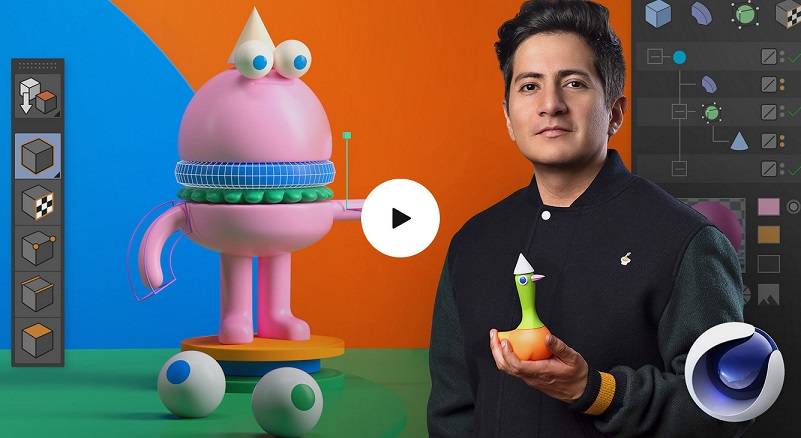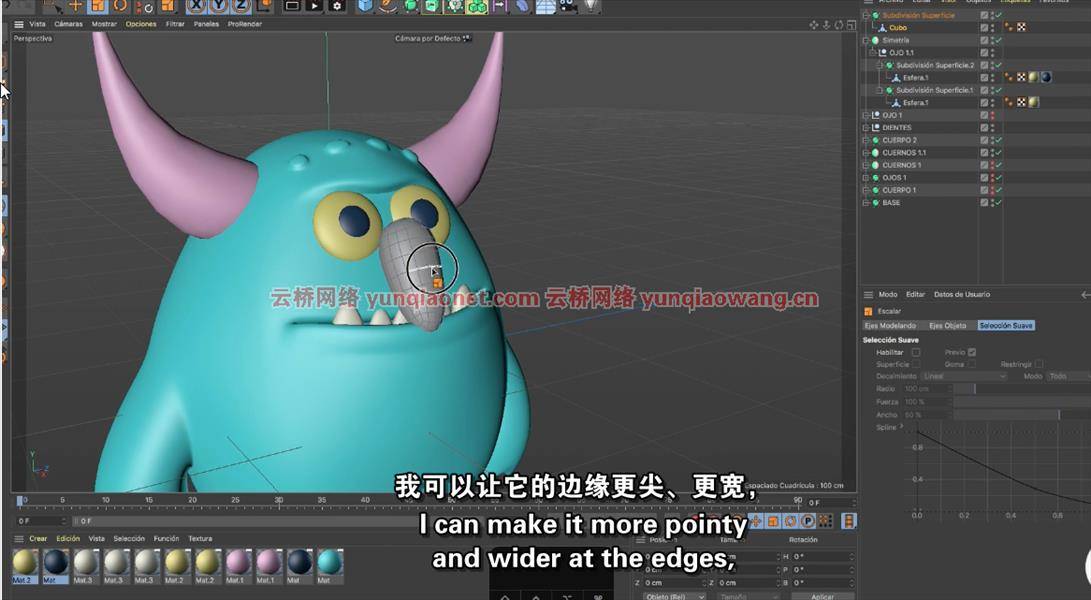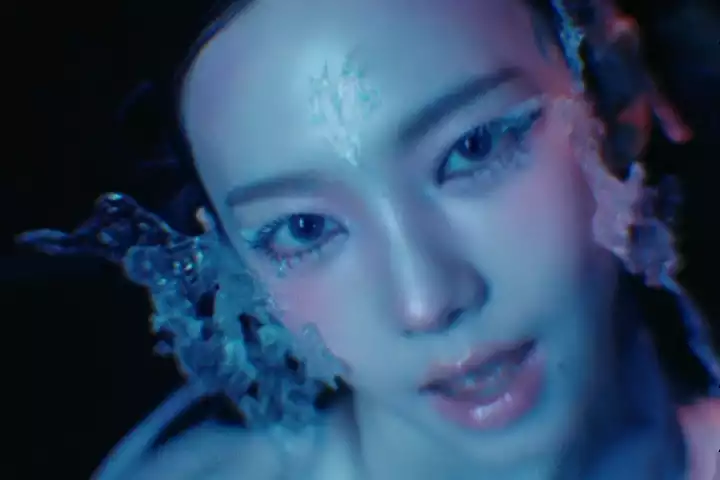
了解如何以专业的方式对3D角色进行建模、纹理化、光照和渲染
学习如何使用C4D等3D软件的一个简单直观的方法是专注于角色的创建。通过使用基本形状和一些工具,您可以对程序有一个完整的了解,这将帮助您面对日益复杂的项目。Cinema 4D for Character Creation (Spanish, multisub)
插画家和3D设计师Aarón Martínez开发了一套完整的方法,通过6门课程以直观的方式学习如何使用Cinema 4D,从而在很短的时间内取得出色的成果。
如果您想与 Aarón 一起增加 3D 设计知识,您还可以参加他的一些其他课程:Cinema 4D 中的角色:从草图到 3D 打印、Cinema 4D 中的原型和产品查看、Cinema 4D 和 OctaneRender 的合成、3D插图与C4D。
课程时长:9小时10分钟 1920X1080 mp4 语言:英语+中英文字幕(云桥CG资源站 机译)含课程文件

首先了解软件的界面,以及一些版本之间的差异;查看浏览程序、创建和修改对象、层次结构等的不同方式。
在第二门课程中,您将首次了解角色设计,从头开始创建角色,无需参考,使用软件的基本工具创建形状并添加颜色。
继续学习如何以水果和蔬菜为参考来创建角色,介绍对称、照明和不同材料的使用等工具和技术。
接下来,以食品和包装为参考,学习如何简化物体的形状和建模。了解如何添加眼睛、嘴巴、手和样条线投影。
在第五门课程中,学习如何对动物和植物进行建模,并开始使用 Pose Morph 等工具来改变位置和表情。
在《Domestika 基础知识》的第六门也是最后一门课程中充分发挥您的想象力,为人物和怪物建模各种角、眼睛、鼻子、头发和嘴巴。
课程目录:
课程 1 – 简介
01. 演示
02. Cinema 4D r21 及其版本之间的差异
03. 第一个文档和工作环境
04. C4D 中的界面和不同的移动方式
05. 原始图形
06. 可编辑对象#点、线和面
07. 体积矢量
08. 对称性、连接器和元球
09. 曲面细分简介
10. 添加和删除线条
11. 练习 – 创建和修改
课程 2 – 逐步发展角色
01. 自发角色
02. 变形器
03. Mograph(克隆器)
04. 模拟#刚性和软物体
05. 基本材质
06. 输出到基本渲染
07. 练习 – 第一个角色
课程 3 – 水果和蔬菜
01. 人物草图
02. 原始对象和分段数量的选择
03. 身体塑造
04. 腿和手臂
05. 眼睛类型
06. 个性
07. 纹理
08. 使用 HDRI 渲染
09. 练习 – 柑橘类和苍蝇
10.练习——柑橘家族和一只苍蝇2
课程 4 – 食品和包装
01. 人物草图
02. 部分食物建模
03. 样条投影细节 1
04. 样条投影细节 2
05. 手部建模
06. 对象联合
07. 瓶子建模
08. 瓶子建模 2
09. 构图
10. 材料
11. 渲染天空
12. 练习 – 汉堡的各个部分
课程 5 – 动物和植物
01. 人物草图
02. 动物造型
03. 动物造型 2
04. 性格、配饰和姿势
05. 植物和盆栽造型
06. 纹理
07. 渲染
08. 练习 – 人物和他的植物
课程 6 – 怪物与人
01. 角色草图
02. 怪物建模
03. 角、鼻子、嘴巴和牙齿
04. 表情、姿势和配件
05. 人体建模
06. 头发类型
07. 角色姿势
08. 配件
09. 纹理
10. 渲染
11. 练习 – 男孩和他的朋友
Domestika – Cinema 4D for Character Creation.
A simple and intuitive way of learning how to use 3D software such as Cinema 4D is to focus on the creation of characters. Through the use of basic shapes and some tools, you can achieve a complete understanding of the program that will help you face increasingly complex projects.
Illustrator and 3D designer Aarón Martínez develops a complete methodology to learn how to use Cinema 4D in 6 courses, in an intuitive way, allowing for grand results in little time.
If you want to increase your knowledge of 3D design with Aarón, you can also take some of his other courses: Characters in Cinema 4D: from the Sketch to 3D Printing, Prototypes and Product Viewing in Cinema 4D, Compositions with Cinema 4D and OctaneRender, 3D Illustration with 4D Cinema 4D.
Start by getting to know the software’s interface, as well as the differences between some versions; see different ways of navigating the program, the creation and modification of the objects, hierarchies, and more.
In the second course, get your first introduction to character design, creating them from scratch and without references, using the software’s basic tools, to create shapes and add color.
Continue learning how to create characters using fruit and vegetables as a reference, introducing tools and techniques such as symmetry, lighting, and the use of different materials.
Next, use food and packaging as your references to learn how to simplify shapes and the modeling of objects. See how to add eyes, mouths, hands, and spline projections.
In the fifth course, learn how to model animals and plants, and start to use tools such as Pose Morph to change positioning and expressions.
Let your imagination take its course in the sixth and last course of this Domestika Basics, modeling people and monsters with a variety of horns, eyes, noses, hair, and mouths.
1、登录后,打赏30元成为VIP会员,全站资源免费获取!
2、资源默认为百度网盘链接,请用浏览器打开输入提取码不要有多余空格,如无法获取 请联系微信 yunqiaonet 补发。
3、分卷压缩包资源 需全部下载后解压第一个压缩包即可,下载过程不要强制中断 建议用winrar解压或360解压缩软件解压!
4、云桥CG资源站所发布资源仅供用户自学自用,用户需以学习为目的,按需下载,严禁批量采集搬运共享资源等行为,望知悉!!!
5、云桥CG资源站,感谢您的赞赏与支持!平台所收取打赏费用仅作为平台服务器租赁及人员维护资金 费用不为素材本身费用,望理解知悉!
6、For users outside China, if Baidu Netdisk is not convenient for downloading files, you can contact WeChat: yunqiaonet to receive a Google Drive download link.














评论(1)
下载素材